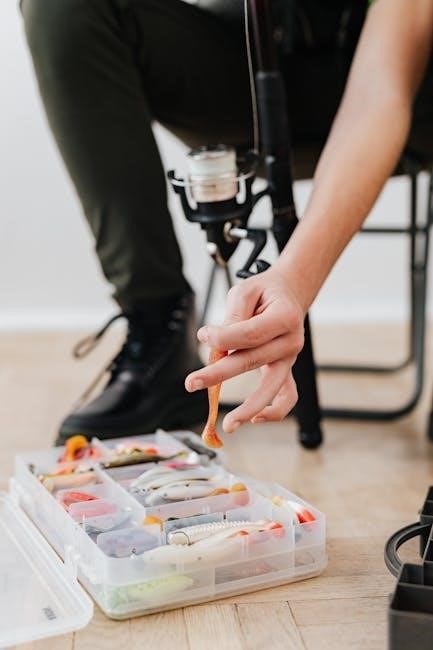Manual rod benders are essential tools for bending metal rods with precision. They are versatile, easy to use, and ideal for both industrial and DIY projects, offering consistent results.
1.1 What is a Manual Rod Bender?
A manual rod bender is a tool designed to bend metal rods into specific shapes and angles. It operates without electricity, relying on manual effort to shape materials like steel or aluminum. These tools are highly portable and suitable for small-scale projects, offering precise control over the bending process. They are commonly used in metalworking, DIY projects, and industrial applications where flexibility and accuracy are essential. Manual rod benders are cost-effective and user-friendly, making them accessible to both professionals and hobbyists. Their simplicity ensures reliability and ease of use, allowing users to achieve consistent results without complex setups. Whether for crafting custom parts or repairing equipment, manual rod benders are indispensable for shaping metal rods efficiently.
1.2 Importance of Manual Rod Benders in Metalworking
Manual rod benders are essential tools in metalworking, offering precision and control when shaping metal rods. They enable the creation of complex bends with minimal effort, making them ideal for intricate designs. Unlike automated systems, manual benders provide a cost-effective solution for small-scale or custom projects. Their portability allows use in various settings, from workshops to remote job sites. Additionally, manual rod benders are versatile, accommodating different materials and sizes, and they require minimal setup. This makes them a valuable asset for both professionals and hobbyists. Their reliability ensures consistent results, and they often serve as a backup when power tools are unavailable. Overall, manual rod benders are indispensable for achieving accurate, high-quality bends in metalworking applications.

Understanding the Basics of Manual Rod Benders
Manual rod benders are tools used to shape metal rods into desired forms. They operate manually, enabling precise control over the bending process. These tools are essential for metalworking.
2.1 Key Components of a Manual Rod Bender
A manual rod bender typically consists of a sturdy frame, a bending die, an adjustment handle, and a gauge for measuring the bend angle. The frame provides stability, while the bending die shapes the rod. The adjustment handle allows precise control over the bending process, and the gauge ensures accuracy. Some models include a foot pedal for hands-free operation, enhancing efficiency. Additional components may include a spring return mechanism to reset the tool after each bend. These elements work together to deliver consistent, high-quality results in metalworking applications.
2.2 How Manual Rod Benders Work
A manual rod bender operates by using mechanical leverage to shape metal rods into precise angles or curves. The user places the rod into the bending die, ensuring it is properly aligned. By turning the adjustment handle, the tool applies pressure to the rod, bending it to the desired angle. Some models include a gauge to measure the bend accurately. The process relies on manual effort, with the tool amplifying the force applied. This method allows for consistent, controlled bends, making it ideal for both small-scale and industrial applications. The simplicity of the mechanism ensures durability and ease of use, providing reliable results for various metalworking tasks.

Choosing the Right Manual Rod Bender
Selecting the right manual rod bender involves considering factors like workload, material type, and desired precision to ensure optimal performance for your specific metalworking needs.
3.1 Factors to Consider When Selecting a Manual Rod Bender
When choosing a manual rod bender, consider the size and thickness of the metal rods, ensuring compatibility with the tool’s capacity. Think about the material type, as different metals like steel or aluminum require varying levels of force. Assess the desired bend type and radius, opting for tools with adjustable settings for precise curves. Evaluate the frequency of use to determine if a basic or heavy-duty model is needed. Prioritize ease of use, with comfortable handles and a smooth mechanism to prevent fatigue. Look for safety features like secure clamping systems and protective guards. Consider portability, choosing a compact design if mobility is essential. Balance cost with required features, ensuring the tool meets your needs within budget. Check maintenance requirements and the availability of parts. Lastly, research the brand and read reviews for insights into reliability and effectiveness.
3.2 Popular Types of Manual Rod Benders
Manual rod benders come in various designs to suit different needs. One popular type is the hand-held portable bender, ideal for small-scale projects and tight spaces. Another is the bench-mounted bender, offering stability and durability for heavy-duty tasks. The ring roller bender is favored for creating smooth, consistent curves in metal rods, often used in DIY and artistic applications. Additionally, lever-operated benders provide superior control and precision, while screw-type benders are known for their simplicity and reliability. Each type caters to specific materials, thicknesses, and bending requirements, making it essential to match the tool to the project’s demands. Understanding these options helps users select the most suitable bender for their work, ensuring efficiency and quality in metalworking tasks.

Safety Tips for Using a Manual Rod Bender
Always wear gloves and safety glasses. Inspect the tool before use. Ensure proper technique to avoid accidents; Keep loose clothing tied back. Avoid distractions while bending.
4.1 Essential Safety Precautions
When using a manual rod bender, prioritize safety to prevent injuries and damage. Always wear safety glasses and gloves to protect yourself from flying debris or sharp edges. Ensure the workspace is clear of clutter and well-lit to avoid tripping or misjudging bends. Inspect the tool before use for any signs of wear or damage, as faulty equipment can malfunction. Keep loose clothing or long hair tied back to prevent entanglement. Never operate the bender when fatigued, as this increases the risk of accidents. Use the correct die size for the material to maintain control and avoid breakage. Always follow the manufacturer’s guidelines and maintain a firm grip during operation. Proper safety practices ensure efficient and hazard-free bending processes.
4.2 Best Practices for Handling the Tool
Proper handling of a manual rod bender ensures precision and longevity. Always maintain a firm, steady grip to prevent slippage and loss of control. Position yourself with good posture and a stable stance to handle the tool effectively. Use the correct die size for the material to avoid overloading the bender. Keep the tool well-maintained by cleaning and lubricating moving parts regularly. Apply steady, controlled pressure during bending to achieve consistent results. Avoid using excessive force, as this can damage the tool or the workpiece. Store the bender in a dry, secure location when not in use to prevent rust or accidental damage. Regularly inspect the tool for wear and tear, addressing issues promptly to maintain performance. Proper handling practices enhance safety, efficiency, and the quality of bends.

Step-by-Step Guide to Using a Manual Rod Bender
A step-by-step guide to using a manual rod bender involves preparing the workpiece, aligning the rod, securing it, applying force, and ensuring precise bends. Follow safety guidelines for accuracy.
5.1 Preparing the Workpiece
Preparing the workpiece is crucial for achieving accurate and consistent bends. Start by cleaning the metal rod to remove dirt, oil, or grease, ensuring a firm grip. Measure and mark the exact point where the bend is required using a marker or caliper. Ensure the material is within the bender’s capacity and suitable for bending. Straighten any warped sections before bending to maintain precision. Finally, align the marked point with the bender’s gauge to set up for the bend. Proper preparation ensures safety, accuracy, and optimal results when using a manual rod bender.
- Clean the rod thoroughly.
- Mark the bend location clearly.
- Verify material specifications.
- Ensure the rod is straight and aligned properly.
5.2 Setting Up the Bender
Setting up the manual rod bender correctly ensures precise bending. Begin by securing the bender firmly on a stable work surface to prevent movement during use. Select the appropriate die based on the size and type of material being bent. Position the die in the bender, ensuring it is aligned with the marked bend point. Adjust the stop or guide to match the desired angle, using the bender’s scale for accuracy. Tighten all components firmly to maintain stability. Always refer to the tool’s manual for specific setup instructions to ensure proper configuration. Proper setup is essential for achieving consistent results and maintaining tool longevity.
- Secure the bender on a stable surface.
- Select the correct die for the material.
- Align the die with the marked bend point.
- Adjust the stop for the desired angle.
5.3 Executing the Bend
Once the bender is set up, place the rod into the die, ensuring it is aligned with the marked bend point. Hold the handle firmly with both hands for maximum control. Apply steady, consistent pressure to execute the bend, maintaining the desired angle. Avoid jerky movements, as they can cause irregular bends or damage the tool. Use a fulcrum point for leverage if needed, especially with thicker materials. Once the bend is complete, carefully remove the rod from the die. Inspect the bend to ensure accuracy and adjust if necessary. Always maintain control throughout the process to achieve precise results.
- Align the rod with the marked bend point.
- Apply steady, consistent pressure.
- Avoid jerky movements for smooth bending.
- Inspect the bend for accuracy.
5.4 Post-Bending Care
After completing the bend, allow the tool and rod to cool down to prevent overheating. Clean the die and bending area to remove any debris or metal shavings. Inspect the bender for wear or damage, addressing any issues promptly. Store the tool in a dry, protected environment to prevent rust or corrosion. Regularly lubricate moving parts to maintain smooth operation. For the bent rod, check for accuracy and smoothness, addressing any imperfections. Proper post-bending care ensures tool longevity and consistent results. Always follow manufacturer guidelines for maintenance.
- Cool down the tool and rod.
- Clean the die and bending area.
- Inspect for wear or damage.
- Store in a dry, protected space.
- Lubricate moving parts regularly.

Applications of Manual Rod Benders
Manual rod benders are used in construction, automotive, and DIY projects for bending steel, copper, and aluminum rods into frames, supports, and custom shapes, ensuring durability and aesthetics.
- Construction: Creating metal frames and structures.
- Automotive: Fabricating exhaust systems and custom parts.
- DIY: Crafting decorative items and furniture.
6.1 Industrial Uses
Manual rod benders are widely utilized in industrial settings for fabricating metal components. They are essential in manufacturing for creating frames, supports, and machinery parts. Industries like construction rely on these tools to bend reinforcing bars and create structural supports. Automotive workshops use them for crafting exhaust systems, roll cages, and custom vehicle parts. Additionally, HVAC professionals employ manual rod benders to shape ductwork and pipes. The precision and versatility of these tools make them indispensable in producing custom metalwork efficiently. They are also used in furniture manufacturing for bending frames and in shelving systems for creating durable structures. Their ability to handle various materials, including steel, aluminum, and copper, ensures their relevance across multiple industries. This versatility makes manual rod benders a cornerstone in modern industrial fabrication processes.
6.2 DIY and Hobbyist Projects
Manual rod benders are invaluable for DIY enthusiasts and hobbyists, offering a practical way to shape metal rods for various creative projects. They are often used in home decor to create custom railings, curtain rods, or decorative accents. Hobbyists leverage these tools for crafting unique furniture pieces, such as bent-leg tables or handrails. Additionally, they are useful for repairing or fabricating garden supports, plant stakes, or DIY sculptures. The affordability and ease of use of manual rod benders make them accessible to individuals without professional training. They also allow for precise control, enabling hobbyists to achieve intricate bends for customized designs. Whether for functional repairs or artistic expression, manual rod benders empower DIYers to bring their creative visions to life with minimal equipment and effort.

Tips and Tricks for Effective Bending
For effective bending, preheat the rod to reduce brittleness, use the correct die size to avoid damage, apply consistent pressure for smooth bends, and lubricate to minimize friction and prevent sticking.
7.1 Avoiding Common Mistakes
Avoiding common mistakes when using a manual rod bender is crucial for achieving precise bends and prolonging tool longevity. One of the most frequent errors is overloading the bender, which can damage its frame. Always ensure the rod diameter matches the bender’s capacity. Another mistake is using the wrong die size, leading to incomplete or uneven bends. Selecting the correct die for the rod material and thickness is essential. Applying uneven pressure can result in misaligned bends, so maintain steady, consistent force. Bending too quickly can cause inaccuracies, so take your time to achieve the desired angle. Additionally, neglecting to lubricate the bending area increases friction and wear, so apply a suitable lubricant before bending. Finally, always secure the workpiece firmly to prevent slippage and ensure safety.
7.2 Optimizing Bending Techniques
Optimizing bending techniques with a manual rod bender involves proper tool setup and precise execution. Start by ensuring the rod is aligned correctly with the bending die to achieve accurate results. Using a bending spring can help maintain the rod’s shape during the process. Apply consistent, controlled pressure to avoid over-bending or creating uneven curves. Gradually increase the bend angle to prevent material stress or fractures. For tighter radii, use a smaller die or adjust the bending angle in increments. Always pre-measure and mark the rod for precise placement. Using a protractor or angle gauge ensures accuracy. Regularly inspect the tool and workpiece for alignment. Keep the workspace clean and organized to avoid distractions. Finally, practice on scrap material to refine your technique before working on final projects.

Maintenance and Care of Manual Rod Benders
Regularly clean with a soft cloth and mild detergent. Apply rust-inhibiting coatings. Avoid harsh chemicals. Inspect for damage and replace worn parts promptly. Touch up scratched surfaces for longevity.
8.1 Cleaning and Lubrication
Regular cleaning and lubrication are essential for maintaining the performance and longevity of a manual rod bender. Use a soft, dry cloth to wipe down the tool, removing dirt, grease, and metal shavings. For tougher grime, dampen the cloth with mild soap water, but avoid harsh chemicals or abrasive cleaners. After cleaning, apply a thin layer of rust-inhibiting oil to exposed metal surfaces. Lubricate moving parts, such as hinges and pivot points, with a high-quality machine oil or silicone-based spray. Repeat this process after every 10-15 uses or when the tool is exposed to moisture. Proper lubrication ensures smooth operation and prevents wear. Always inspect the tool before use and address any corrosion or damage promptly to maintain optimal functionality.
8.2 Storage and Longevity
Proper storage is crucial for extending the life of a manual rod bender. Store the tool in a dry, cool place away from direct sunlight and moisture to prevent rust. Use a protective case or cover to shield it from dust and accidental damage. Avoid storing the bender in extreme temperatures, as this can affect its mechanical performance. Before storage, ensure the tool is clean and dry, with a light coating of rust-inhibiting oil applied to metal surfaces. Organize the bender in a secure location to prevent it from being bent or dropped. Regularly inspect the tool for signs of wear or damage before and after storage. By following these practices, you can ensure your manual rod bender remains in excellent condition for years of reliable service.

Frequently Asked Questions (FAQs)
- What materials can be bent with a manual rod bender? Typically, soft metals like copper, aluminum, and thin steel rods.
- How do I achieve tight radius bends? Use a bender with adjustable dies or a precision tool designed for tight curves.
- Can I bend hardened steel? No, manual rod benders are not suitable for hardened steel due to its rigidity.
- How often should I maintain my bender? Regular cleaning and lubrication of moving parts ensure optimal performance.
9.1 What Materials Can Be Bent with a Manual Rod Bender?
A manual rod bender is primarily designed to bend soft metals like copper, aluminum, and thin steel rods. These materials are ideal due to their flexibility and ease of shaping without requiring excessive force. The tool is most effective for smaller diameters, typically up to 1/2 inch, depending on the bender’s capacity. Hardened metals, such as stainless steel or thick alloy rods, are not recommended as they may damage the tool or resist bending. Always check the manufacturer’s specifications to ensure the material and diameter are within the bender’s limits. Proper material selection ensures safe and precise bending operations.
9.2 How to Achieve Tight Radius Bends
To achieve tight radius bends with a manual rod bender, start by selecting the correct die or bending form that matches your desired radius. Ensure the workpiece is properly secured in the bender, aligning it with the die’s center. Apply steady, controlled pressure to avoid slipping or deforming the material. For tighter bends, use a bender with adjustable stops or a precision gauge to maintain consistency. Heating the material slightly can improve flexibility, but avoid overheating, as this may weaken the metal. Use a mandrel or support to prevent kinking, especially with thinner materials. Practice on scrap metal to refine your technique and achieve the perfect tight radius bend every time.
A manual rod bender is an invaluable tool for precise metalworking, offering versatility and reliability for various projects, from industrial tasks to DIY creations, ensuring consistent results.
10.1 Summary of Key Points
Manual rod benders are essential tools for precision metalworking, offering versatility and reliability across various applications. They enable accurate bending of metal rods, making them indispensable in both industrial and DIY settings. Key considerations include material type, rod thickness, and desired bend radius when selecting a bender. Proper usage involves careful preparation, precise alignment, and controlled force to achieve consistent results. Maintenance is crucial for longevity, with regular cleaning and lubrication ensuring optimal performance. Safety precautions, such as wearing protective gear and following best practices, are vital to prevent accidents. By mastering these aspects, users can unlock the full potential of manual rod benders for efficient and effective metal shaping in both professional and hobbyist projects.
10.2 Final Thoughts on Manual Rod Benders
Manual rod benders are indispensable tools for metalworking, offering unparalleled precision and control for shaping metal rods. Their versatility, ease of use, and durability make them a valuable asset for professionals and hobbyists alike. By mastering the techniques and safety guidelines outlined, users can achieve consistent, high-quality results. These tools empower creativity and efficiency, enabling the creation of complex designs with minimal effort. Investing in a high-quality manual rod bender ensures long-term reliability and satisfaction. Whether for industrial applications or DIY projects, manual rod benders remain a cornerstone of metal fabrication, providing both practicality and artistic freedom. With proper care and skill, they continue to be an essential resource for any metalworking enthusiast.

Additional Resources
Explore online forums, manufacturer websites, and tutorials for in-depth guides and tool recommendations. Join metalworking communities for shared insights and expert advice on manual rod benders.
11.1 Recommended Tools and Accessories
When working with manual rod benders, consider investing in essential tools and accessories to enhance efficiency and precision. Bending dies and pivot pins are crucial for achieving accurate bends. A sturdy workbench or clamping system ensures stability during operation. Measuring tools, such as calipers and protractors, help in verifying angles and dimensions. Lubricants and cleaning solvents maintain the tool’s performance and longevity. Safety gear, including gloves and goggles, is indispensable for protecting yourself during bending tasks. Optional accessories like adjustable stops and radius gauges can further refine your bending process. For intricate projects, consider upgrading to specialized dies or interchangeable bending heads. These accessories collectively ensure optimal results and extend the lifespan of your manual rod bender.
11.2 Further Reading and Tutorials
For those seeking to deepen their understanding of manual rod benders, various resources are available. Books on metalworking and fabrication often include detailed sections on rod bending techniques. Online tutorials and YouTube channels dedicated to metalworking provide step-by-step guides and demonstrations. Websites like Udemy and Coursera offer courses on metal fabrication, covering tools like manual rod benders. Forums and communities, such as Reddit’s r/metalworking, are excellent for sharing experiences and tips. Additionally, manufacturer websites often provide PDF guides and troubleshooting tips specific to their models. Workshops or local classes can also offer hands-on training. These resources help users master bending techniques, troubleshoot common issues, and explore creative applications of manual rod benders in various projects.




